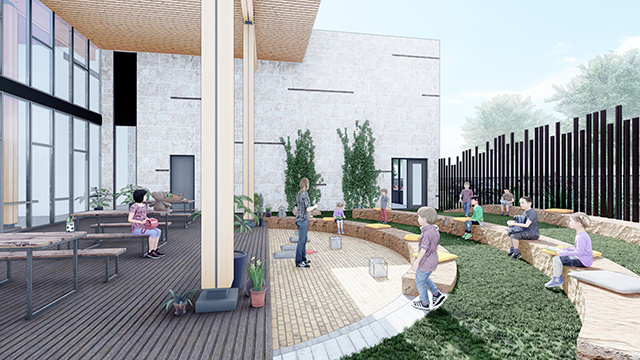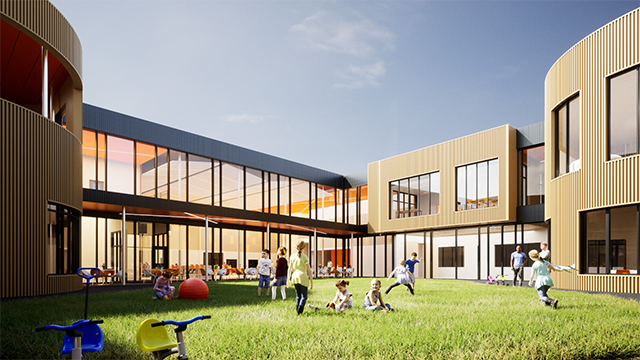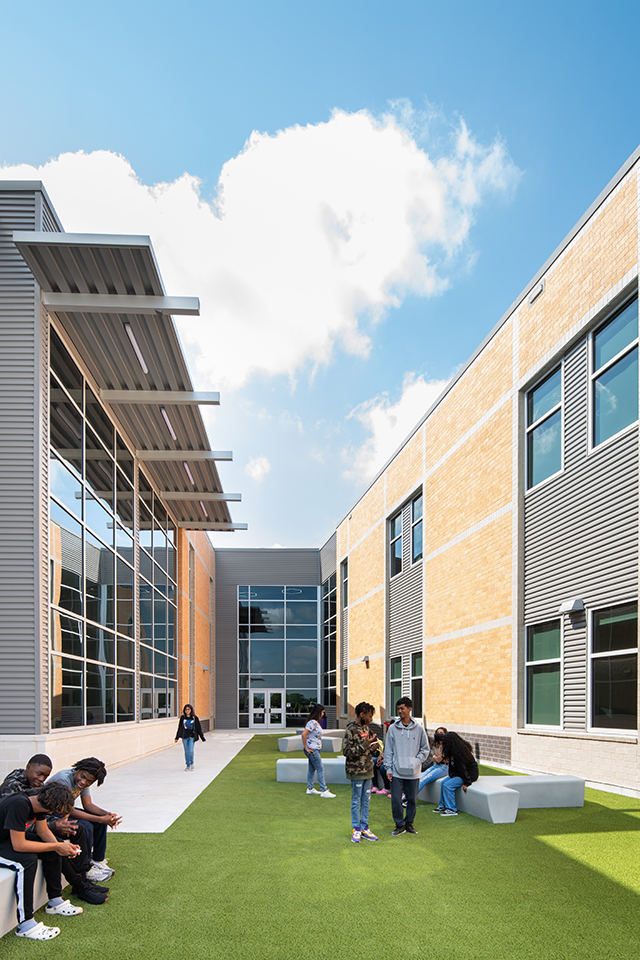Reimagine Outdoor Spaces as Dynamic Learning Environments
Benefits and solutions for creating outdoor learning areas and programming at your school
By Brenda Swirczynski, ALEP
We've all heard it a million times. "Go outside and get some fresh air." Well, Mom was right, and not just about being bored on a summer afternoon. There’s solid research that shows taking the classroom outside can be a game-changer, especially when it is introduced early to our youngest learners.
- Academic Advantages: Nature sparks curiosity and joy in learning. It turns instructional journeys into real adventures and learning activities into stories lived and felt, weaving the natural world directly into the fabric of learning.
- Balancing Screen Time with Green Time: The active nature of outdoor learning combats sedentary lifestyles, encouraging more movement and physical engagement.
- Socio-Emotional Development: The calming effect of nature, combined with the collaborative opportunities it presents, nurtures essential socio-emotional skills like empathy, teamwork and resilience.
- Environmental Literacy: Exploring and learning outdoors sparks wonder and enables us to make real-world connections to the natural world. It helps us understand how our actions affect the environment and encourages a sense of responsibility.

Images courtesy of Pfluger Architects
Those all sound great, but I get it, it can be a challenge getting buy-in.
Possible Challenges to Outdoor Learning
- Safety: "It's not safe. There are bugs, and what if kids run away?"
We start by establishing clear boundaries and objectives for the activity.
Modern school designs can integrate safe and secure outdoor learning spaces. Pfluger Architects' design for the new Denton Elementary School in Denton, Texas, creates an interior courtyard that provides collaborative and flexible space for hands-on learning and gives students and teachers a break from the classroom. The collaboration spaces and science lab will connect with the central courtyard to encourage interaction and exploration.
- Control: "When I take my students outside, they immediately want to play on the playground."
Different Spaces for Different Activities.
By intentionally separating recess areas and learning areas, students will understand the outdoors is not only a place to play but also a place to learn. At the new PreK4SA South School in San Antonio, Texas, outdoor learning environments and playgrounds will be between classroom wings. Each outdoor learning space will cater to distinct age groups and promote exploratory and gross motor play using non-traditional natural elements like sand and water tables, rock scramble areas and climbing elements—all to create safe and engaging spaces for children.
- Comfort: "It's too hot. There is no shade. My students don't want to sit on the ground."

Provide carpet squares or pads to improve comfort during outdoor activities.
But also, just find the shade and go there! Goose Creek's EF Green Junior School was designed so both courtyards stay shaded throughout the day, so students have comfortable outdoor spaces at all times.
So, the question stands: how do we bring this vision to life? It starts with reimagining outdoor spaces as dynamic environments that invite exploration, discovery and creative thinking for learning that takes advantage of those spaces. To activate outdoor learning on your campus, consider breaking down the concept into distinct, practical elements:
Sensory Adventures: Tapping into Natural Curiosity
Young learners naturally use their senses to explore and understand the world around them. Taking learning outdoors harnesses this curiosity in a fun and educational way. Sound mapping is one of my favorite ways to do this. It's simple: students find a cozy spot outdoors, sit quietly and tune into the sounds around them. They might sketch what they hear, jot notes or just count with their fingers. Then, we bring those discoveries back to the classroom and put together a chart of the sounds collected. Bonus points if the students can identify the source of the sound they heard!
Materiality: The Building Blocks of Our Campus
Turn the campus into a discovery zone where students can uncover the materials that make up their world. Start with an engaging task: ask them to look around and identify three different materials. A tree introduces wood, the school walls showcase brick, and playground equipment brings metal into the conversation. This task, as straightforward as it seems, opens their eyes to the hidden stories of common objects. To further refine their observational skills, encourage students to use a journal for deeper engagement with these materials. They can write, draw, map or even do rubbings. Challenge them to think about the properties—is the surface rough or smooth? Is the material natural or manufactured? And if it's manufactured, what natural resource did it come from?
Understanding Ecosystems: Exploring Life's Boundaries
Elementary education often introduces the division between living (biotic) and non-living (abiotic) components of an ecosystem. Building on this concept, take students outside to test their knowledge. Instruct students to seek out and categorize examples of living and non-living things around them, using evidence to support their choices. Is a leaf that's fallen still considered living? What about a stick—does it count as alive? Concrete might seem lifeless, yet a small, vibrant flower breaking through a crack suggests otherwise. If your students struggle with focusing, try using hula hoops or circles of yarn to define a workspace and keep their investigation on track.
As you can tell, I am passionate about getting kids outside to learn new things. Moving education beyond the classroom can help teach students that learning happens everywhere, curiosity doesn’t have a beginning or end, and studying something new can be fun.

Some of my own favorite outdoor learning experiences:
Part of my graduate thesis work on stream restoration included taking students from Fort Worth's Stripling Middle School to a local stream. We explored what was living in the stream, the water flow and what that meant for the water quality. Then, the students figured out how to help improve the water—skills and knowledge they could take back and do on their own campuses.
During my time as the Education Coordinator at the Botanical Research Institute of Texas, I had the honor to collaborate with botanists to develop a new educational program and space, now part of the Fort Worth Botanic Garden. With the freedom to think innovatively, we sought to redefine traditional learning approaches that provide student visitors the opportunity to learn in unique settings. Today students will find a pocket prairie, a crafted natural area with native grasses and wildflowers behind the main building. Here, students can walk through the space using socks to mimic the natural movements of bison and other native animals historically involved in seed dispersal.
Creating learning opportunities and connections with nature improves cognitive development as well as mental and physical wellbeing. The benefits of taking education outside are numerous and start with reimagining outdoor spaces as dynamic environments that invite exploration, discovery and creative thinking for learning that takes advantage of those spaces.
Former science teacher and outdoor learning curriculum expert Brenda Swirczynski is a Certified Accredited Learning Environments Planner (ALEP) and Educational Facility Planner for Pfluger Architects.